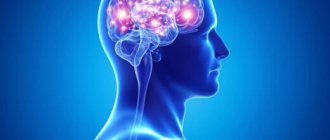What is DEDUCTION - in simple words. DEDUCTION METHOD
In simple words, Deduction is a type of thinking in which a person makes certain logical conclusions based on knowledge about a class of things as a whole, and transfers certain features to a specific thing. In other words, we can say that deduction is a version of logical reasoning directed from the general to the specific.
Despite the ornate definition, the concept of deduction itself is very simple, especially if you understand the principle of the deductive method. So, the Deductive Method works as follows: If we know that all representatives of a certain class have some property, then when considering one of the representatives of this class, it is fair to assume that he also has this property. So for example: If we know that all people are mortal, and the hypothetical Seryozha is a man, then, therefore, he is also mortal.
Field of psychology
The English thinker Thomas Hobbes was the first to mention the phenomena in psychology we are considering in his works. His merit was the unification of rational and empirical knowledge. Hobbes insisted that there can only be one truth, achieved through experience and reason. In his opinion, knowledge begins with sensibility as the first step towards generalization. The general properties of phenomena are established using induction. Knowing the actions, you can find out the cause. After clarifying all the reasons, we need the opposite path, deduction, which makes it possible to understand new and different actions and phenomena. Examples of induction and deduction in psychology according to Hobbes show that these are interchangeable stages of one cognitive process, passing from each other.
What is INDUCTION - in simple words, definition, meaning.
Induction or Inductive reasoning is a method of constructing a logical conclusion based on the principle: from the particular to the general. So, for example, if we see that the hypothetical Seryozha died, and he is a man, then we can assume that all people are mortal .
Examples of deductive reasoning
At first glance, this definition may seem somewhat difficult to understand. But in reality everything is very simple. To understand how deductive thinking works, here are some examples:
- If all living people are mortal, then a particular man or boy is also mortal, since they are also people.
- Birds fly with feathers. If a parrot has feathers, then it is a bird.
- The most iron is found in red meat. We see that beef is meat with a reddish-brown tint; accordingly, it contains more iron than other types of meat.
- Reptiles belong to the cold-blooded category. Snakes are reptiles, which means they are similarly cold-blooded.
- If A equals B and B equals C, then A = C.
To summarize, we can say about deduction and induction that:
Inductive and deductive reasoning are two opposing, but not mutually exclusive, approaches that can be used to evaluate conclusions. Deductive reasoning presupposes the presence of a general statement, from which a conclusion about a particular case is subsequently drawn. On the other hand, inductive reasoning takes as a basis a series of particular cases from which a general theory is formed. There are differences in the approaches, but it is important to understand that both inductive and deductive reasoning can be false, especially if the underlying premise of the argument is incorrect. The best option when constructing logical conclusions is to use a combination of these methods.
Note: Sherlock Holmes (a literary character created by Arthur Conan Doyle) did not use only the deductive method. In most cases, he built his conclusions using the model of inductive reasoning.
Sphere of pedagogy
The method of induction and deduction is often used in school education. Methodological literature for teachers is organized inductively. This type of thinking is widely applicable to studying technical devices and solving practical problems. And with the help of the deductive method it is easier to describe a large number of facts, explaining their general principles or properties. Examples of deduction and induction in pedagogy can be observed in any lesson. Often in physics or mathematics, the teacher gives a formula, and then during the lesson the students solve problems that fit this case.
In any field of activity, the methods of induction and deduction are always useful. And you don’t have to be a super detective or a genius in scientific fields to do this. Give your thinking a workout, develop your brain, train your memory, and in the future complex tasks will be solved on an instinctive level.
Observation. Measurement. Experiment
In addition to all the above methods, science also uses other methods for knowledge. They are empirical and theoretical.
Empirical methods are:
- Observation is the perception of reality aimed at a specific object or phenomenon.
- Measurement is a process of cognition in which the parameters of the object of study are correlated with a known unit of measurement.
- An experiment is a special process in which an object is subjected to various influences to determine the behavior of its parameters under given changed conditions.
A very important role in scientific knowledge is assigned to the process of observation. Observation provides science with empirical information that is needed to set new goals and objectives when studying a particular object, as well as to form scientific hypotheses. These hypotheses are tested by conducting experiments. Measurement is also a very important component of scientific knowledge. Here is what the famous English thinker W. Thomson said about this process: “If you know how to measure an object, then you know something about it; if you don’t know how to measure it, then you don’t know anything about it.”
The main task of the experiment is to test certain hypotheses and theories put forward.
Theory as a special form of scientific knowledge
Theory is a set of conclusions that reflect objectively existing relationships and connections between the phenomena of objective reality. Thus, theory is an intellectual reflection of reality. Theoretically, each conclusion is derived from other conclusions based on some rules of inference. The ability to predict is a consequence of theoretical constructs. Theories are formulated, developed and tested using the scientific method.
A theory is a doctrine, a system of ideas or principles. This is a set of generalized provisions that make up a science or its section. Theory acts as a form of synthetic knowledge, within which individual concepts, hypotheses and laws lose their former autonomy and become elements of an integral system.
There are other definitions of theory, in which any conclusion is called such, regardless of the objectivity of this conclusion. As a result, various hypothetical constructs are often referred to as theories, such as the geosyncline theory, etc. This can be seen as an attempt to give weight to the hypothetical construct, that is, an attempt to mislead.
In the pure sciences, a theory is an arbitrary set of sentences of some artificial language, characterized by precise rules for constructing expressions and understanding them.
Any theory performs a number of functions. Let us denote the most significant functions of the theory:
- theory provides the user with conceptual structures;
- theoretical terminology is being developed;
- theory allows us to understand, explain or predict various manifestations of the object of the theory.
Types of knowledge
Objective-logical thinking presupposes a general line; an example is the transition of society from one formation to another.
The objective-historical method is a concrete manifestation of a certain pattern in the infinite variety of its individual manifestations and features. In society, as an example, we can use the connection of individual destinies with the real history of the country.
Testing the theory
It is generally believed that the standard method for testing theories is direct experimental verification (experiment is the criterion of truth). However, often a theory cannot be tested by direct experiment (for example, the theory of the origin of life on Earth), or such testing is too difficult or expensive (macroeconomic and social theories), and therefore theories are often tested indirectly. An experiment, but based on the presence of predictive power - that is, if unknown / previously undetected events follow from it and with careful observation these events are detected, then the predictive power is present.
In fact, the theory-experiment relationship is more complex. Since the theory already reflects objective phenomena previously tested experimentally, it is impossible to draw such conclusions. At the same time, since the theory is built on the basis of the laws of logic, conclusions are possible about phenomena that were not established by early experiments, but verified by practice. However, these conclusions should already be called a hypothesis, the objectivity of which, that is, the translation of this hypothesis into the rank of theory, is confirmed by experiment. In this case, the experiment does not test the theory, but clarifies or expands the provisions of this theory.
To summarize, the applied goal of science is to predict the future, both in the observational sense - to describe the course of events over which we cannot influence, and in the synthetic sense - to create the desired future using technology. Figuratively speaking, the essence of the theory is to link together circumstantial evidence, render a verdict on past events and indicate what will happen in the future if certain conditions are met.
LiveInternetLiveInternet
Quote from Rodislav's message
Read in full In your quotation book or community!
Analysis and synthesis, induction and deduction
Methods of scientific knowledge, inseparable from each other and in close unity and interconnection, can be divided into two groups: general and special.
General methods make it possible to link together all aspects of the cognition process. Their objective basis is the general laws of cognition. These include the method of ascent from the abstract to the concrete, the unity of the logical and historical, etc.
Special methods concern only one side of the subject being studied. These are observation, experiment, analysis, synthesis, induction, deduction, measurement, comparison.
In natural science, special methods of science are given extremely important importance, therefore, within the framework of this work, we will consider their essence in more detail. The main special methods are analysis, synthesis, induction and deduction.
We can also say that analysis and synthesis are techniques of scientific thinking that give rise to special methods in each area.
The relevance of this topic is due to the fact that analysis-synthesis and induction-deduction play an important role both in philosophical and in any other knowledge, and are understood as synonymous with any scientific research.
1. PROCESSES OF ANALYSIS AND SYNTHESIS
Analysis-synthesis as the essence, as the content and form of human thinking, as techniques and methods of scientific thinking is comprehensively studied in multiple dimensions and by many sciences. Analysis and synthesis (from the Greek analysis - decomposition, dismemberment, synthesis - connection) are two universal, oppositely directed operations of thinking.
There are several senses in which the terms “analysis” and “synthesis” are used:
- analysis and synthesis as characteristics of the structure of proof in mathematics; in this sense they talk about analytical and synthetic methods;
- analysis and synthesis in the sense of Kant’s distinction between “analytical” and “synthetic” judgments, which actually means distinguishing the method of obtaining knowledge through purely logical processing of a given experience (“analytical”) from the method of obtaining knowledge by referring to the content, by bringing to the original knowledge some then other data of experience (“synthetic”);
- Most often, the terms “analysis” and “synthesis” are used in relation to all thinking in general, to research in general.
Based on this, analysis is a procedure for mentally (sometimes real) dividing the object under study into its component parts, considering all aspects and ways of functioning of the property and studying them. Dismemberment aims to move from the study of the whole to the study of its parts and is carried out by abstracting from the connection of the parts with each other.
Synthesis is a procedure for combining parts of objects, their sides or properties obtained as a result of analysis into a single whole, considering the method of connections and relationships of parts, without which truly scientific knowledge of this subject is impossible.
Analysis and synthesis are used both in mental and practical, in particular experimental, activities. Different sciences use specific methods of analysis and synthesis, and each field has special methods.
In a general sense, thinking as a whole is “analysis-synthesis”, the division of objects of consciousness and their unification. It arises already at the stage of sensory cognition, when we decompose phenomena into individual aspects and properties, highlighting their shape, color, size, constituent elements, etc. By understanding objects, we perform analysis. The selected parts can become the subject of independent, deeper study, and certain relationships and dependencies can be established between them. Any thinking is the establishment of some kind of relationship between objects fixed in thought or their sides, that is, synthesis. The subsequent synthesis restores the integrity of the object, but after its analytical study we become more deeply aware of the structure of this integrity. The relationship between synthesis and analysis is a certain process. It is based on the connection of abstractions in which thinking is carried out.
Dialectical thinking presupposes unity, a combination of analysis and synthesis in the course of studying a subject. Hegel, who proceeded from the activity of thinking and posed the problem of analysis and synthesis as a problem of logical thinking, in his works substantiated the unity of analysis and synthesis, their dialectics, showed the correlation between the categories of part and whole and the contradictory nature of the process of reflecting an object as a part and a whole.
Building a theory about a subject area presupposes the presence of both analytical and synthetic knowledge about each subject of this area, objectively consisting of parts: special knowledge about individual objects of communication and knowledge about the properties of connection of objects, which contains the result of processing individual knowledge together.
In everyday life, isolating a specific thought from the thick fog of layers of visual images, sounds, aromas and tastes - from everything that makes up our life, we usually use two qualities of the mind: the ability to analyze and the ability to synthesize.
By analyzing, we divide big ideas into smaller ones. By synthesizing, we combine a certain amount of information based on a certain principle. Recognizing the complexity of the vast amount of information we receive, we try to sort our thoughts into certain categories. We place mental brackets in the material of our accumulated life experience.
In many professions, to become a master of your craft, you must master the art of classification by perceiving individual details, classifying them in your mind based on certain criteria, integrating this information and formulating thoughts regarding the object as a whole.
Procedures of analysis and synthesis are a necessary element of any scientific knowledge. Analysis is usually its first stage, when the researcher moves from an undifferentiated description of the object under study to identifying its structure, composition, as well as its properties and characteristics.
In the process of scientific knowledge, synthesis, as a rule, follows analysis. Synthesis acts not as a method of constructing the whole, but as a method of representing the whole in the form of a unity of knowledge obtained through analysis. In synthesis, there is not just a unification, but a generalization of the analytically identified and studied features of the object. The provisions obtained as a result of synthesis are included in the theory of the object, which, enriched and refined, determines the path of new scientific research.
This knowledge is used in theory in different and relatively independent ways. Let's look at some examples of the use of analysis and synthesis in scientific knowledge.
In chemistry, when considering a number of compounds that in turn react with each other, knowledge about the properties of the compound as a whole must be replaced by knowledge about its individual parts, since their quantitative characteristics are important. In other sciences, as a rule, knowledge is used undifferentiated, as synthetic.
In mechanics, depending on the needs of constructing a theory, or in the conditions of solving more complex problems, either knowledge about the component forces or knowledge about the resultant force is used (for example, the addition and expansion of forces according to the parallelogram rule). The construction of a theory or the general course of research can be characterized here from the point of view of the logical conditions for the possibility of replacing one knowledge, a number of others, or a number of knowledge with one, if there is coordination of various objects in the subject area (recorded, respectively, in special knowledge) and manifestations of the results of this coordination in the properties of the whole. Synthetic knowledge is never a simple mechanical sum of knowledge about parts; it represents new knowledge (for example, when applied to several forces, one has to construct the parallelogram rule and the resulting one is not equal to the simple sum of the forces).
Structurally, the unity of analysis and synthesis means both the interdependence of knowledge (analytical and synthetic) or research tasks, and the characteristics of the method of implementing each of them separately. Already the elementary process of reflecting the simplest coordination and its various elements is both analysis and synthesis in the sense of obtaining analytical knowledge through synthesis and synthetic knowledge through analysis.
In scientific knowledge, the deductive method is a special case of analysis, and the inductive method is a special case of synthesis. Analysis and synthesis are used as thinking techniques, and induction and deduction as methods.
2. INDUCTIVE AND DEDUCTIVE METHODS
Rational judgments are traditionally divided into deductive and inductive. The question of using induction and deduction as methods of knowledge has been discussed throughout the history of philosophy. In contrast to analysis and synthesis, these methods were often opposed to each other and considered in isolation from each other and from other means of cognition.
In the broad sense of the word, induction is a form of thinking that develops general judgments about individual objects; this is a way of moving thought from the particular to the general, from less universal knowledge to more universal knowledge (the path of knowledge “from the bottom up”).
By observing and studying individual objects, facts, events, a person comes to know general patterns. No human knowledge can do without them. The immediate basis of inductive inference is the repeatability of features in a number of objects of a certain class. A conclusion by induction is a conclusion about the general properties of all objects belonging to a given class, based on the observation of a fairly wide variety of individual facts. Typically, inductive generalizations are viewed as empirical truths, or empirical laws. Induction is an inference in which the conclusion does not follow logically from the premises, and the truth of the premises does not guarantee the truth of the conclusion. From true premises, induction produces a probabilistic conclusion. Induction is characteristic of experimental sciences, it makes it possible to construct hypotheses, but does not provide reliable knowledge, but is suggestive.
Speaking about induction, we usually distinguish between induction as a method of experimental (scientific) knowledge and induction as a conclusion, as a specific type of reasoning. As a method of scientific knowledge, induction is the formulation of a logical conclusion by summarizing observational and experimental data. From the point of view of cognitive tasks, they also distinguish between induction as a method of discovering new knowledge and induction as a method of substantiating hypotheses and theories.
Induction plays a major role in empirical (experiential) knowledge. Here she speaks:
- one of the methods for the formation of empirical concepts;
- the basis for constructing natural classifications;
- one of the methods for discovering cause-and-effect patterns and hypotheses;
- one of the methods of confirming and justifying empirical laws.
Induction is widely used in science. With its help, all the most important natural classifications in botany, zoology, geography, astronomy, etc. were built. The laws of planetary motion discovered by Johannes Kepler were obtained using induction based on an analysis of the astronomical observations of Tycho Brahe. In turn, Keplerian laws served as an inductive basis for the creation of Newtonian mechanics (which later became a model for the use of deduction). There are several types of induction:
- Enumerative or general induction.
- Eliminative induction (from the Latin eliminatio - exclusion, removal), containing various schemes for establishing cause-and-effect relationships.
- Induction as reverse deduction (the movement of thought from consequences to foundations).
General induction is an induction in which one moves from knowledge about several objects to knowledge about their totality. This is a typical induction. It is general induction that gives us general knowledge. General induction can be represented by two types: complete and incomplete induction. Complete induction builds a general conclusion based on the study of all objects or phenomena of a given class. As a result of complete induction, the resulting conclusion has the character of a reliable conclusion.
In practice, it is more often necessary to use incomplete induction, the essence of which is that it builds a general conclusion based on the observation of a limited number of facts, if among the latter there are no ones that contradict the inductive inference. Therefore, it is natural that the truth obtained in this way is incomplete; here we obtain probabilistic knowledge that requires additional confirmation.
Complete mathematical induction should be considered an independent type of inductive inference. It is widely used in mathematics.
The inductive method was already studied and applied by the ancient Greeks, in particular Socrates, Plato and Aristotle. But special interest in the problems of induction appeared in the 17th-18th centuries. with the development of new science. The English philosopher Francis Bacon, criticizing scholastic logic, considered induction, based on observation and experiment, to be the main method of cognition of truth. With the help of such induction, Bacon intended to look for the cause of the properties of things. Logic should become the logic of inventions and discoveries, Bacon believed; Aristotelian logic, set out in the work “Organon,” cannot cope with this task. Therefore, Bacon writes the work “New Organon”, which was supposed to replace the old logic. Another English philosopher, economist and logician John Stuart Mill also extolled induction. He can be considered the founder of classical inductive logic. In his logic, Mill devoted much attention to the development of methods for studying causal relationships.
During the experiments, material is accumulated for analyzing objects, identifying some of their properties and characteristics; the scientist draws conclusions, preparing the basis for scientific hypotheses, axioms. That is, there is a movement of thought from the particular to the general, which is called induction. The line of knowledge, according to supporters of inductive logic, is built like this: experience - inductive method - generalization and conclusions (knowledge), their verification in an experiment.
The principle of induction states that universal statements of science are based on inductive conclusions. This principle is referred to when it is said that the truth of a statement is known from experience. In modern scientific methodology, it is realized that it is generally impossible to establish the truth of a universal generalizing judgment using empirical data. No matter how much a law is tested by empirical data, there is no guarantee that new observations will not appear that will contradict it.
Unlike inductive reasoning, which only suggests a thought, through deductive reasoning one derives a certain thought from other thoughts. The process of logical inference, which results in the transition from premises to consequences based on the application of the rules of logic, is called deduction. There are deductive inferences: conditionally categorical, separative-categorical, dilemmas, conditional inferences, etc.
Deduction is a method of scientific knowledge, which consists in the transition from certain general premises to particular results and consequences. Deduction derives general theorems and special conclusions from experimental sciences. Gives reliable knowledge if the premise is true. The deductive method of research is as follows: in order to obtain new knowledge about an object or a group of homogeneous objects, it is necessary, firstly, to find the closest genus into which these objects belong, and, secondly, to apply to them the corresponding law inherent to all this kind of objects; transition from knowledge of more general provisions to knowledge of less general provisions.
In general, deduction as a method of cognition is based on already known laws and principles. Therefore, the deduction method does not allow us to obtain meaningful new knowledge. Deduction is only a way of logical development of a system of propositions based on initial knowledge, a way of identifying the specific content of generally accepted premises.
Aristotle understood deduction as evidence using syllogisms. The great French scientist Rene Descartes extolled deduction. He contrasted it with intuition. In his opinion, intuition directly perceives the truth, and with the help of deduction, the truth is comprehended indirectly, i.e. by reasoning. Distinct intuition and necessary deduction are the way to know the truth, according to Descartes. He also deeply developed the deductive-mathematical method in the study of natural science issues. For a rational method of research, Descartes formulated four basic rules, the so-called. "rules for guiding the mind":
- That which is clear and distinct is true.
- Complex problems must be divided into specific, simple problems.
- To go to the unknown and unproven from the known and proven.
- Conduct logical reasoning consistently, without gaps.
A method of reasoning based on the deduction of consequences and conclusions from hypotheses is called the hypothetico-deductive method. Since there is no logic of scientific discovery, no methods guaranteeing the acquisition of true scientific knowledge, scientific statements are hypotheses, i.e. are scientific assumptions or assumptions whose truth value is uncertain. This position forms the basis of the hypothetico-deductive model of scientific knowledge. In accordance with this model, the scientist puts forward a hypothetical generalization, from which various kinds of consequences are deductively derived, which are then compared with empirical data. The rapid development of the hypothetico-deductive method began in the 17th-18th centuries. This method was successfully applied in mechanics. The studies of Galileo Galilei and especially Isaac Newton turned mechanics into a harmonious hypothetico-deductive system, thanks to which mechanics became a model of science for a long time, and for a long time they tried to transfer mechanistic views to other natural phenomena.
The deductive method plays a huge role in mathematics. It is known that all provable propositions, that is, theorems, are derived logically using deduction from a small finite number of initial principles, provable within the framework of a given system, called axioms.
But time has shown that the hypothetico-deductive method was not omnipotent. In scientific research, one of the most difficult tasks is the discovery of new phenomena, laws and the formulation of hypotheses. Here the hypothetico-deductive method rather plays the role of a controller, checking the consequences arising from the hypotheses.
In the modern era, extreme points of view about the meaning of induction and deduction began to be overcome. Galileo, Newton, Leibniz, recognizing the great role of experience, and therefore induction in cognition, noted at the same time that the process of moving from facts to laws is not a purely logical process, but includes intuition. They assigned an important role to deduction in constructing and testing scientific theories and noted that in scientific knowledge an important place is occupied by a hypothesis, which cannot be reduced to induction and deduction. However, for a long time it was not possible to completely overcome the opposition between inductive and deductive methods of cognition.
In modern scientific knowledge, induction and deduction are always intertwined with each other. Real scientific research takes place in an alternation of inductive and deductive methods; the opposition of induction and deduction as methods of cognition loses its meaning, since they are not considered as the only methods. In cognition, other methods play an important role, as well as techniques, principles and forms (abstraction, idealization, problem, hypothesis, etc.). For example, in modern inductive logic, probabilistic methods play a huge role. Assessing the likelihood of generalizations, searching for criteria for substantiating hypotheses, the establishment of complete reliability of which is often impossible, requires increasingly sophisticated research methods.
CONCLUSION
Special
The methods we studied in our work relate to local knowledge and relevant theories.
Analysis and synthesis of broader concepts, induction and deduction are methods used specifically in cognition. Perhaps this is why the role of analysis and synthesis in scientific knowledge and in mental activity in general has not caused such disputes and contradictions among scientists and philosophers as discussions about the role of the inductive and deductive method.
Analysis and synthesis not only complement each other, there is a deeper internal connection between them, which is based on the connection of abstractions, which actually shapes thinking.
Analysis and synthesis as methods of scientific thinking, applicable always and to everything, give rise to special methods in each area, and inductive and deductive methods are used selectively. Analysis correlates with deduction, and synthesis with induction.
The development of the doctrine of induction led to the creation of inductive logic, which states that the truth of knowledge comes from experience. The development of the teachings of deduction led to the creation of a fairly progressive hypothetico-deductive method - the creation of a system of deductively interconnected hypotheses from which statements about empirical facts are derived. Subsequently, the opposition of the inductive method to the deductive one was overcome and modern scientific knowledge is unthinkable without the use of all special methods.
The dialectical method of thinking as a whole represents the rules for analyzing and synthesizing complex systems of connections, which are a means of revealing the necessary internal connections of an organic whole with the totality of its aspects using inductive and deductive methods.
Taken from here https://revolution.allbest.ru/








